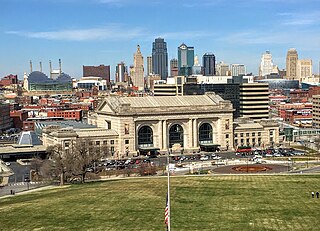
Downtown Kansas City is the central business district (CBD) of Kansas City, Missouri and the Kansas City metropolitan area which contains 3.8% of the area's employment. It is between the Missouri River in the north, to 31st Street in the south; and from the Kansas–Missouri state line eastward to Bruce R. Watkins Drive as defined by the Downtown Council of Kansas City; the 2010 Greater Downtown Area Plan formulated by the City of Kansas City defines the Greater Downtown Area to be the city limits of North Kansas City and Missouri to the north, the Kansas–Missouri state line to the west, 31st Street to the south and Woodland Avenue to the east. However, the definition used by the Downtown Council is the most commonly accepted.

The Leland Stanford Mansion, often known simply as the Stanford Mansion, is a historic mansion and California State Park in Sacramento, California, which serves as the official reception center for the Californian government and as one of the official workplaces of the Governor of California.

The architecture of the Kansas City Metropolitan Area, especially Kansas City, Missouri, includes major works by some of the world's most distinguished architects and firms, including McKim, Mead and White; Jarvis Hunt; Wight and Wight; Graham, Anderson, Probst and White; Hoit, Price & Barnes; Frank Lloyd Wright; the Office of Mies van der Rohe; Barry Byrne; Edward Larrabee Barnes; Harry Weese; and Skidmore, Owings & Merrill.
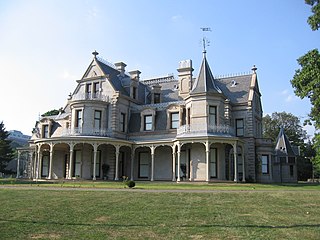
The Lockwood–Mathews Mansion is a Second Empire style country house in Norwalk, Connecticut. Now a museum, it was built in 1864-68 for railroad and banking magnate LeGrand Lockwood. The 62-room 44,000 square feet (4,100 m2) mansion was listed on the National Register of Historic Places and was declared a National Historic Landmark in 1978.

Union Square is a neighborhood located in the Sowebo area of Baltimore. It dates to the 1830s and includes a historic district of houses and commerce buildings.
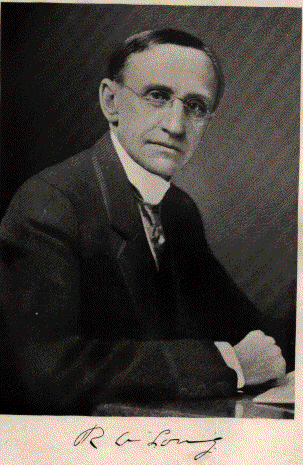
Robert Alexander Long was an American lumber baron, developer, investor, newspaper owner, and philanthropist. He lived most of his life in Kansas City, Missouri and founded Longview, Washington and Longville, Louisiana.

The National World War I Museum and Memorial in Kansas City, Missouri was opened in 1926 as the Liberty Memorial. In 2004, it was designated by the United States Congress as the country's official war memorial and museum dedicated to World War I. A non-profit organization manages it in cooperation with the Kansas City Board of Parks and Recreation Commissioners. The museum focuses on global events from the causes of World War I before 1914 through the 1918 armistice and 1919 Paris Peace Conference. Visitors enter the exhibit space within the 32,000-square-foot (3,000 m2) facility across a glass bridge above a field of 9,000 red poppies, each representing 1,000 combatant deaths.

The Missouri Governor's Mansion is a historic U.S. residence in Jefferson City, Missouri. It is located at 100 Madison Street. On May 21, 1969, it was added to the U.S. National Register of Historic Places. It is located in the Missouri State Capitol Historic District.

The South Carolina Governor's Mansion is a historic U.S. governor's mansion in the Arsenal Hill neighborhood of Columbia, South Carolina and the official residence of the governor of South Carolina. It is a Federal style home influenced by British Colonial plantations. The building has a white stucco exterior and originally served as faculty quarters for the Arsenal Academy, which together with the Citadel Academy in Charleston formed the South Carolina Military Academy. The Arsenal was burned along with the city of Columbia by Sherman's forces in February, 1865; the structure was the only surviving building and became South Carolina's executive mansion in 1868. On June 5, 1970, the building was registered with the U.S. National Register of Historic Places. The mansion is located on a single city block, and is surrounded by magnolia plants, elm and oak trees, and various other plants. It is accessed by a circular driveway around a fountain in front on the residence's main entrance. The building has a flat roof and a large central pavilion around the main entrance. The mansion has 15 rooms. It is located in Columbia Historic District I. The mansion is currently occupied by Governor Henry McMaster and his family.
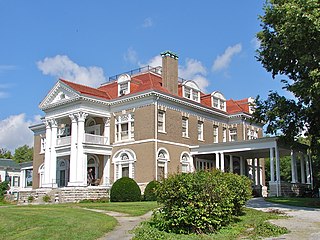
Rockcliffe Mansion is located in Hannibal, Missouri (USA) and was built in 1898 by John J. Cruikshank, Jr, a descendant of Scottish immigrants, whose fortune was founded on lumber. He erected the residence on West Bird Street. It came to be acknowledged as the most imposing, beautiful and costly residential structure in that part of the state of Missouri. "By reason of its location on a high, rocky eminence, overlooking the entire city [and the Mississippi River], it [was] termed 'Rock Cliff' [later known as "Rockcliffe"], and is one of the many attractions of the city invariably viewed by strangers and tourists visiting Hannibal." It is located in the Maple Avenue Historic District.

The Dupee Estate, located at 400 Beacon Street in the village of Chestnut Hill, Newton, Massachusetts, was the last home of Mary Baker Eddy, the founder of Christian Science.
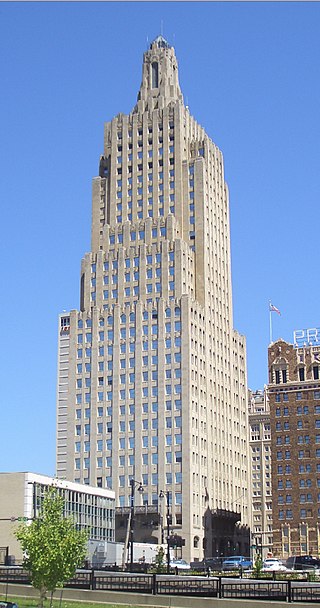
Hoit, Price & Barnes was a prominent Kansas City architectural firm in the early 20th century. It designed several skyscrapers and mansions including three of the current ten tallest buildings in Kansas City; the Kansas City Power and Light Building, 909 Walnut, and Oak Tower.
Jarvis Hunt was a Chicago architect who designed a wide array of buildings, including railroad stations, suburban estates, industrial buildings, clubhouses and other structures.

Briarcliff was the mansion and estate of Asa Griggs "Buddy" Candler Jr. (1880–1953), and is now the Briarcliff Campus of Emory University. The estate was built in 1922 on 42 acres on Williams Mill Road, now Briarcliff Road in Druid Hills near Atlanta. Williams Mill Road would be renamed Briarcliff Road in the 1920s after the estate that Asa Jr. would build there. It was listed on the National Register of Historic Places in 1988.
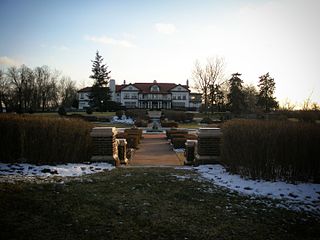
Longview Farm in Lee's Summit, Missouri, United States was built by Robert A. Long. In planning the farm Long turned to Henry F. Hoit of Hoit, Price and Barnes, as he had designed Corinthian Hall and the R.A. Long Building. George Kessler was chosen as the landscape architect. The farm and over 50 other structures were built on 1,780 acres. Construction started in 1913 and completed in 1914 taking just 18 months to complete. The result is what came to be known as The World's Most Beautiful Farm. Construction workers included 50 Belgian craftsmen and 200 Sicilian stonemasons, among 2,000 other workers, to build the Longview Mansion and farm.

Kansas City Union Station is a union station opened in 1914, serving Kansas City, Missouri, and the surrounding metropolitan area. It replaced a small Union Depot from 1878. Union Station served a peak annual traffic of more than 670,000 passengers in 1945 at the end of World War II, quickly declined in the 1950s, and was closed in 1985.

Union Station is a building in Houston, Texas, in the United States. Dedicated on March 2, 1911, and formerly a hub of rail transportation, the building now serves as a cornerstone for Minute Maid Park. It is listed on the National Register of Historic Places, and has since been superseded by Houston's Amtrak station.

Henry Ford Hoit was a well-known Kansas City, Missouri, architect in the early 20th century. He and his partners designed many of Kansas City's most iconic commercial and residential buildings including the Kansas City Power and Light Building and the R.A. Long residence.



















